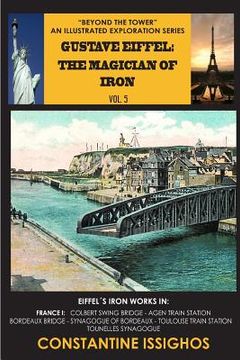Reseña del libro "Gustave Eiffel: The Magician of Iron: Eiffel Exploration Series (en Inglés)"
The Eiffel Illustrated Exploration Series is divided in a number of illustrated volumes: Vol. 1 "Beyond the Tower" deals with Eiffel's iron works in USA, Mexico and Ecuador. Vol. 2 " Art of Metal Structures" deals with a number of Eiffel's metal projects in Peru and Chile, Vol. 3 "Genius of Iron Works" illustrates Eiffel's iron structures in Argentina and Bolivia. These 3 volumes completes Eiffel's list of metal works in the Americas. Vol. 4 "Art and Strength in Architecture" illustrates Eiffel iron buildings and structures in Portugal and Spain. In this Vol. 5 "The Magician of Iron" it illustrates a number of Eiffel' iron structures in Southern-France, Vol. 6 "The Iron Lady" concentrates on Eiffel's creations in the city of Paris including the famous Eiffel Tower, Vol. 7 "Genius of Harmonious Design" narrates Eiffel's works in central France, Vol.8 "Engineer and Scientist" describes Eiffel's various structures and his participation of telecommunication and aerodynamics. It also describes Eiffel's iron buildings and structures in Eastern Europe, Latvia, Hungary, Romania and Turkey. In the decades following the French Revolution of 1789, the city of Paris began to witness major changes in its architectural infrastructure based on economic and social considerations. Innovative technology in bridges, railways and street gas-lighting were not only conveniences but also necessity for the rise of a new economic and political class: the bourgeoisie or middle class. Paris was known for its narrow and dark street corridors. Female pedestrians tended to "chock" out of fear when passing these dark and dank corridors with their subterranean odours and atmosphere of profound danger. For the poor of Paris, the much needed "modernization" was a necessity and a relocation curse. Streets had to be surveyed and the areas marked which were to be renovated. All infrastructures were promoted by Napoleon III in an attempt to modernized Paris and to some degree the rest of the French country side.The "Age of Construction" saw a massive building program of Paris beatification of the 1850's and beyond. Eiffel's iron works were part of that program presented in this volume. This was the core desire of the revolutionary middle-class which boosted the events of the French Revolution. It took an authoritarian regime of Napoleon III to convince the capitalist of the day to initiate important projects which could benefit society as a whole, but not particular the poor who would left on their own. The basis of the economic development would be the financial institutions the likes of the Credit Lyonnais, which at the time went into considerable financial expansion and other private entrepreneurs who were financed by the banks and loans backed by the French State. During this time marked by the growth of of machinery, mass production factories and the rising for products and common necessities, country folks were enticed to move from agricultural work to cottage-industries and look for jobs in the cities. The middle-class was very active in participating and adopting advanced technology in transportation, medicine, machinery and architecture. This relatively new political class seemed to want for novelties in economics, arts and culture and the general re-organization of things as they were. As such there was an advanced opportunity for the middle-class to exhibit and enjoy their wealth in cafes, restaurants and theaters and fancy department stores. Eiffel's iron works in various projects contributed to the general renovation of the French society. This volume deals with such iron projects which contributed to the re-organization of urban structure witnessed today by million of visitors.

